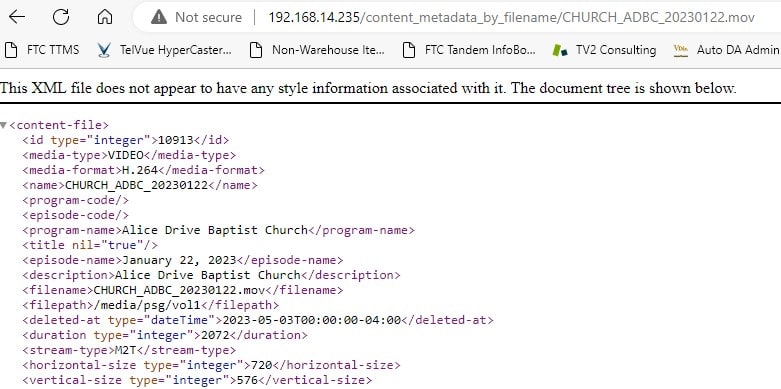JasonCannon
IS-IT--Management
Hello,
A vendor I work with upgraded a few of their servers we use and now a VFP program that connects to it via its APIs has started erroring.
This code use to work.
Instead now the PostResult file sending this:
Any thoughts or recommendations? I have reached out them and waiting to hear back, too
Much thanks,
Jason....
"..if you give a man a fish he is hungry again in an hour. If you teach him to catch a fish you do him a good turn."
-- Anne Isabella Thackeray Ritchie.
A vendor I work with upgraded a few of their servers we use and now a VFP program that connects to it via its APIs has started erroring.
This code use to work.
Code:
**** HyperCaster API Info
sHyperCaster = "[URL unfurl="true"]http://192.168.14.235/"[/URL]
sADDFolder = "content_api"
sCMbyFN = "content_metadata_by_filename/"
fnMedia = "CHURCH_ADBC_20230122.mov"
oXMLHTTP = CREATEOBJECT("Microsoft.XMLHTTP")
*** Get metadata from HyperCaster
*** Content Metadata by Filename POST
oXMLHTTP.Open("POST", sHyperCaster + sCMbyFN + fnMedia, .f.)
oXMLHTTP.setRequestHeader('Content-Type', 'application/x-[URL unfurl="true"]www-form-urlencoded')[/URL]
oXMLHTTP.Send()
lcSendText = sHyperCaster + sCMbyFN + fnMedia
? lcSendText
lcResultText = oXMLHTTP.responseText
STRTOFILE(lcResultText,"C:\Temp\VFP\PostResult-"+fnMedia+".txt")Instead now the PostResult file sending this:
XML:
<!DOCTYPE HTML PUBLIC "-//W3C//DTD HTML 4.01 Transitional//EN"
"[URL unfurl="true"]http://www.w3.org/TR/html4/loose.dtd">[/URL]
<html xmlns="[URL unfurl="true"]http://www.w3.org/1999/xhtml"[/URL] xml:lang="en" lang="en">
<head>
<meta http-equiv="content-type" content="text/html; charset=UTF-8" />
<title>Not Found</title>
<link rel="icon" href="/favicon.ico" type="image/x-icon" />
<link rel="shortcut icon" href="/favicon.ico" type="image/x-icon" />
<style media="screen" type="text/css">
html { font-family: "Trebuchet", "Trebuchet MS", sans-serif; padding: 85px 10px; font-size: 19px; line-height: 1.4; color: #737373; background: #f0f0f0 url("/images/500_error_background.png") }
body { max-width: 575px; _width: 575px; padding: 30px 20px 50px; border: 1px solid #b3b3b3; -moz-border-radius: 4px; -webkit-border-radius: 4px; border-radius: 4px; margin: 0 auto; -moz-box-shadow: 0 1px 15px #333, inset 0 1px 0 #fff; -webkit-box-shadow: 0 1px 15px #333, inset 0 1px 0 #fff; box-shadow: 0 1px 15px #333, inset 0 1px 0 #fff; background: #fcfcfc; text-align: center; }
h1 { margin: 10px; font-size: 34px; text-align: center; }
p { margin: 1em 0; text-align: center;}
img { margin: -10px auto 16px auto; }
ul { margin: 40px auto 0 auto; padding: 0; list-style-type: none; text-align: center; }
ul li { font-size: .9em; margin:10px 8px; display: inline; text-align: center; }
li a { text-decoration: none; }
a img {border: none; }
div.dialog { max-width: 500px; _width: 500px; margin: 0 auto; }
</style>
</head>
<body>
<div class="dialog">
<a href="[URL unfurl="true"]http://www.telvue.com/"[/URL] target="_blank"><img id="logo" src="/images/telvuelogo.gif" height="68" width="246" alt="TelVue Corporation" title="TelVue Corporation" /></a>
<h1>Page Not Found</h1>
<p>Sorry, you may have mistyped the address or the page may have moved.</p>
<ul>
<li><a href="[URL unfurl="true"]http://telvue.com/support/"[/URL] target="_blank">Technical Support</a></li>
<li><a href="[URL unfurl="true"]http://www.telvue.com/support/product-documentation/"[/URL] target="_blank">Product Documentation</a></li>
<li>(800)-885-8886</li>
</ul>
</div>
</body>
</html>Any thoughts or recommendations? I have reached out them and waiting to hear back, too
Much thanks,
Jason....
"..if you give a man a fish he is hungry again in an hour. If you teach him to catch a fish you do him a good turn."
-- Anne Isabella Thackeray Ritchie.

